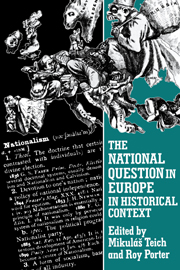Book contents
- Frontmatter
- Contents
- List of maps
- Notes on contributors
- Acknowledgements
- Introduction
- 1 The British Isles: Celt and Saxon
- 2 The making of the French nation
- 3 The national question in Italy
- 4 The roots of the national question in Spain
- 5 Shifting nationalism: Belgians, Flemings and Walloons
- 6 The nation in German history
- 7 Nationalism and nation-state in Germany
- 8 The national identity of the Austrians
- 9 The Czechs
- 10 The national question in Hungary
- 11 The union of Dalmatia with northern Croatia: a crucial question of the Croatian national integration in the nineteenth century
- 12 The national question in Poland in the twentieth century
- 13 Finland: from Napoleonic legacy to Nordic co-operation
- Index
8 - The national identity of the Austrians
Published online by Cambridge University Press: 30 November 2009
- Frontmatter
- Contents
- List of maps
- Notes on contributors
- Acknowledgements
- Introduction
- 1 The British Isles: Celt and Saxon
- 2 The making of the French nation
- 3 The national question in Italy
- 4 The roots of the national question in Spain
- 5 Shifting nationalism: Belgians, Flemings and Walloons
- 6 The nation in German history
- 7 Nationalism and nation-state in Germany
- 8 The national identity of the Austrians
- 9 The Czechs
- 10 The national question in Hungary
- 11 The union of Dalmatia with northern Croatia: a crucial question of the Croatian national integration in the nineteenth century
- 12 The national question in Poland in the twentieth century
- 13 Finland: from Napoleonic legacy to Nordic co-operation
- Index
Summary
Nationalism — a world intoxicated with collective nomenclature. For example, the fact that I am an Austrian means that I share a common label with an abundance of repellent individuals; because of this, I do not want to accept that I be categorized solely in terms of such a concept.
Heimito von Doderer, Repertorium. Ein Begreifbuch von höheren und niederen Lebens-Sachen, ed. D. Weber (Munich, 1969), p. 164AUSTRIA
To simplify the discussion we will define ‘Austria’ only as the territory constituting the Republic of Austria since 1919 and since 1945; it follows that the inhabitants of this territory may logically be described as ‘Austrians’. This, however, cannot avoid the complications arising from the fact that this Austria was for a long time a part of a much greater power structure, which was also known as ‘Austria’. It is preferable to call this greater power structure ‘the Habsburg Monarchy’ for the period after 1867. In doing so, one should not forget that the name ‘Austria’ had been identified with the Land of the same name which had existed since 1156, and which is today the province of Lower Austria. The Land of Upper Austria (Austria above the Enns) is also included in this definition of ‘Austria’.
- Type
- Chapter
- Information
- The National Question in Europe in Historical Context , pp. 196 - 227Publisher: Cambridge University PressPrint publication year: 1993
- 5
- Cited by



